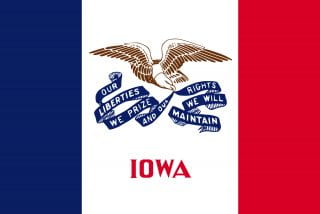 Avery Hasten is a junior honors international studies and history student from O’Fallon, Missouri. She is very involved in the Associated Student Government where she serves as the Director of Open Education Resource and is a member of Delta Gamma. After college, Avery plans on pursuing a career in foreign policy.
Avery Hasten is a junior honors international studies and history student from O’Fallon, Missouri. She is very involved in the Associated Student Government where she serves as the Director of Open Education Resource and is a member of Delta Gamma. After college, Avery plans on pursuing a career in foreign policy.
Every presidential election cycle, Iowa come out of the woods as a state to watch. The Iowa Caucus is examined closely as an early indicator of national feelings towards the front runners who are trying to get a spot on the general election ballot. Iowa has a strong history of being a swing state in general elections. In the last twelve general elections, Iowa has supported the Republican candidate six times and the Democratic candidate six times, correctly predicting the general election winner nine out of the twelve elections.
The 2016 election was a landslide victory for President Trump with a 9.4% lead over Hillary Clinton. The margin between candidates was staggering with very significant support for President Trump through the rural regions of Iowa, winning all but six counties in the state. However, this election in 2020 is expected to be much closer. Iowa’s six electoral votes are still up for grabs. The most recent polling average from Real Clear Politics as of October 29 shows Biden with a 1.5% lead over President Trump which is too narrow of a margin to call. Trump is in for quite a fight if he wants to win Iowa.
President Trump and the Republican party have been working hard to secure the victory as they did in 2016. Trump has held multiple rallies in the last few months in an effort to gain support. His rally on October 15 did not deliver the expected boost in support seeing as he dropped one point in the poll in the preceding week. His desperation for support can be seen in the amount of money being spent in Iowa alone. NPR reported this week that the Trump campaign and allies spent $12.3 million in television advertisements with $3.8 million being directly from the campaign itself. A poll done in the beginning of October by the Des Moines Register suggests that the issues in this election vary in importance between Republican and Democrats. In the poll results, 31% of Republicans listed the economy as being the most important with only 10% of Democrats listing the economy first. Amidst the current pandemic, 30% Democrats are voting on the COVID-19 response as their primary issue. President Trumps is trying to appeal to the economic successes during his term by highlighting the positive impact his trade deals have had on Iowan farmers. Despite his various attempts to regain his 2016 base in Iowa, he still does not have the impressive lead he did four years ago.
Vice President Joe Biden is leading the fight for Iowa just five days before the election. The midterm elections of 2018 reflects a shift in party realignment for the state with three out of four House seats going to the Democratic candidate which was shocking after President Trump’s landslide victory in 2016. Iowa has also had a poor COVID-19 response with thousands of reported deaths since March. Biden has utilized this in his campaign efforts by attacking the President’s response to the pandemic many times. Biden has spent a comparable $3.3 million in advertising with $3.2 coming from his campaign alone indicating he is fighting for the state as equally as President Trump. Biden has one more stop in Iowa before the November 3rd to continue his momentum and secure the votes of the undecided. Iowa’s suburbs are not as conservative this election cycle as they were in 2016. The national transition of support from suburban women is a big factor in Biden’s polling success right now as Iowa has a large suburban population. Biden has an 11-point lead over President Trump with the suburban woman of Iowa and Trump recognized this in his last rally in Des Moines. Biden’s campaign strategy has been very effective in blurring the party lines for this election and bringing Iowa back to its swing state status.
Prediction: My prediction for Iowa in the presidential election is that they will support Joe Biden by a margin of two to three percent. It has been apparent during the last few months of polling in the state there has been a sharp decline in support for President Trump. The tight race between the two candidates signifies that Trump does not have the same support base he did in 2016. I think that Iowans will follow national attitudes as it does each election and support the winning candidate. The same base that got President Trump in office is not as strong this election cycle and that will reflect in Iowa’s voting record for the 2020 presidential election.
